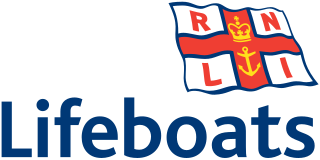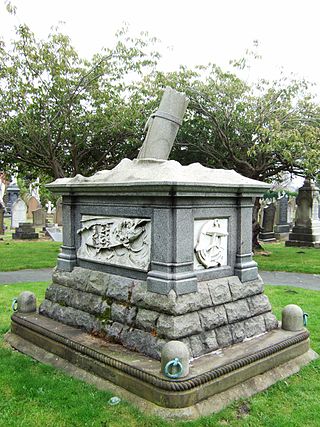
The Royal National Lifeboat Institution (RNLI) is the largest of the lifeboat services operating around the coasts of the United Kingdom, the Republic of Ireland, the Channel Islands, and the Isle of Man, as well as on some inland waterways.

The Penlee lifeboat disaster occurred on 19 December 1981 off the coast of Cornwall, England. The Royal National Lifeboat Institution (RNLI) lifeboat Solomon Browne, based at the Penlee Lifeboat Station near Mousehole, went to the aid of the vessel Union Star after its engines failed in heavy seas. After the lifeboat had rescued four people, both vessels were lost with all hands. Sixteen people died, including eight volunteer lifeboatmen.

The Southport and St Anne's lifeboats disaster, commonly known as the Mexico disaster after the ship involved, occurred on the evening of the 9th December 1886. In all, 27 lifeboat men lost their lives trying to save the crew of the ship.

Henry George Blogg GC BEM was a lifeboatman from Cromer on the north coast of Norfolk, England, and the most decorated in Royal National Lifeboat Institution (RNLI) history.
Since its inception, the Royal National Lifeboat Institution (RNLI) has provided lifeboats to lifeboat stations in the United Kingdom and Ireland.

Great Yarmouth and Gorleston lifeboat station is a RNLI base in Norfolk, England. There were originally two separate stations at Great Yarmouth and Gorleston – two coastal towns either side of the River Yare. These were merged in 1926.

Sheringham Lifeboat Station is an RNLI operated lifeboat station located in the town of Sheringham in the English county of Norfolk. Since 1992, the station has been inshore operations only - currently with an Atlantic 85 rigid inflatable - offshore lifeboats are to the east at Cromer and the west at Wells-next-the-sea.

RNLB Benjamin Bond Cabbell II was a Cromer non self-righter type lifeboat stationed at Cromer Lifeboat Station in the English county of Norfolk from September 1884 until September 1902.

Wells-next-the-Sea Lifeboat Station is a lifeboat station in the town of Wells-next-the-Sea in the English county of Norfolk. The station, run by the Royal National Lifeboat Institution, operates both inshore and offshore lifeboats. The inshore boat is a D-class (IB1) lifeboat named Peter Wilcox (D-707), whilst the offshore lifeboat is Shannon-class 13-46 named Duke of Edinburgh (ON 1161). The station boathouse is located at the beach on the western side of Wells Harbour mouth.

Penlee Lifeboat Station is the base for Royal National Lifeboat Institution (RNLI) search and rescue operations for Mount's Bay in Cornwall, United Kingdom. The lifeboat station operated at various locations in Penzance from the early 19th century. It moved to Penlee Point near Mousehole in 1913, thus gaining its current name, but was moved to Newlyn in 1983 without any change of name. The station is remembered for the loss of the entire lifeboat crew on 19 December 1981.

The Brede-class lifeboat was operated by the Royal National Lifeboat Institution (RNLI) from its stations around the coasts of the United Kingdom between 1982 and 2002, at which time it was the fastest all-weather lifeboat in its fleet. Eleven were put into service and when replaced by larger boats, seven were sold for further use as lifeboats, mainly in South Africa.

Aldeburgh Lifeboat Station is an RNLI station located in the town of Aldeburgh in the English county of Suffolk.

RNLB Lucy Lavers was an RNLI lifeboat which was on No. 2 station at Aldeburgh from 1940 until 1959 when she was placed in the reserve fleet until 1968 when she was retired. The Rescue Wooden Boats Charity is currently undertaking restoration of the vessel. The Lucy Lavers is entered in the National Historic Ships register and has the Certificate No 2206.

Hunstanton Lifeboat Station is a Royal National Lifeboat Institution operated lifeboat station located in the village of Old Hunstanton in the English county of Norfolk. This is the only lifeboat station on the east coast of England which faces westward, being positioned on the east side of the square-mouthed bay and estuary known as The Wash.

Ryde Inshore Rescue Service is a voluntary run lifeboat station located in the town of Ryde on the Isle of Wight. Ryde Inshore Rescue is an independent lifeboat station within the United Kingdom. It is not part of the Royal National Lifeboat Institution and does not receive funding from the RNLI or the government.

Happisburgh Lifeboat Station is a Royal National Lifeboat Institution (RNLI) Inshore lifeboat station close to the village of Happisburgh in the English county of Norfolk in the United Kingdom. Since 2003 the station boathouse has been re-located from the village to an area south called Cart Gap. This is because the beach below Happisburgh disappeared due to coastal erosion and the stations slipway and access was washed away. The original boathouse in the village is now used for training.
Independent lifeboat services in Britain and Ireland began to be established around the coasts towards the end of the 18th century in response to the loss of life at sea. More recently, independent services have been set up in response to the increasing popularity of coastal and river sport and leisure activities.

Scarborough Lifeboat Station is a Royal National Lifeboat Institution (RNLI) operated lifeboat station in Scarborough, North Yorkshire, England. A lifeboat was established at Scarborough in 1801, which makes it the third oldest lifeboat station in the United Kingdom.

Staithes and Runswick Lifeboat Station is a Royal National Lifeboat Institution (RNLI) lifeboat station based in the village of Staithes, North Yorkshire, England. The station was first opened in 1875 but has been closed for two periods between then and the 21st century due to a decline in the fishing industry and the ability to supply people to crew the lifeboat. It is now host to an Inshore Lifeboat (ILB).
The Peake-class lifeboats were the most numerous lifeboats operated by the Royal National Lifeboat Institution (RNLI) around the coasts of the United Kingdom including Ireland between the 1850s and the 1890s.
































